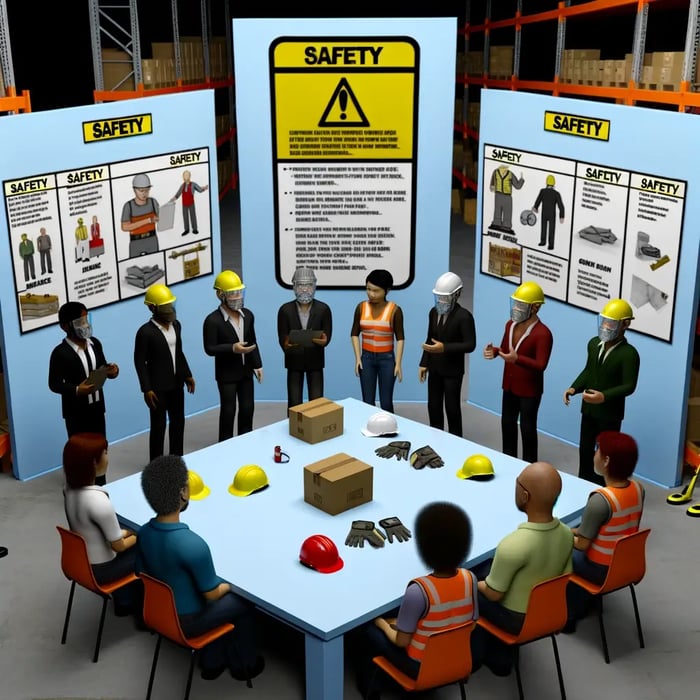No Products in the Cart

Welcome back, everyone to Mighty Line Minute, in our series this month on effective safety messaging. For those who had the opportunity to experience the total eclipse, what a great experience that was! The day will be remembered for a long time, and the stories will go on for ages to come.
Today in our discussion of effective safety communication, we’ll talk a bit about other tools that can be used; for example, “Props.” Props are tools that we can use in our communications to increase and improve the likelihood of success so that we can get the desired behavior or affect the desired change.
Let me give you some examples:
Signage is one example of a prop that can be used. During the eclipse, I brought along my Mighty Line® sign for severe weather, and I posted that where we were sitting.
With signage, however, it is crucial that the most effective and useful signage is selected and used; otherwise, the message may be lost.
Equally, it’s important to make sure that you don’t overuse signage to the point that the accurate message is not really understood and appreciated.
I have an interesting story to tell you about a plant manager that once overused safety signage. Specifically, he was being provided with free monthly safety posters over a course of several years. During an audit of the operation, it was observed that the entire wall of the plant was loaded with safety posters, to the point that it presented a fire risk. They had to be taken down.
Equally concerning was the fire chief I recall from my high school days, when he ordered the removal of all signs and banners lining the entire length of the gymnasium, particularly those at the top edge of the stands where people were seated. They went nearly all the way up to the ceiling. He pointed out the fire risk that was involved.
What's important here is to ensure that you are choosing your messaging appropriately, ensuring that it clearly conveys what needs to be said, is effectively communicated, and is placed where people can see the message, react appropriately, and understand its meaning.
But does it always happen? It’s your job to make sure that it does!
On that note regarding responsibility for determining effective messaging, if you notice something that doesn't make sense, could be better communicated, or is an area lacking the communication that should be provided, speak up! Because we are all in this together, it's critical that we, as a team, decide what needs to be put into place so that we achieve the necessary behaviors and changes.
And remember also that safety is everyone’s responsibility, so be sure to speak up when the message isn’t clear, could be made clearer, or when you have a better idea about how an important message should be communicated.
And finally, regarding the effectiveness and use of props during your communications, I recall a time when I needed to convince an executive of the critical importance of implementing a higher level of fire protection and design.
In doing so, the professional had a background that was primarily financial. How was I to communicate with that individual regarding the need for fire research and improved fire protection? In one pocket I carried a standard 17/32” large orifice sprinkler. And in the second pocket, I carried an "Early Suppression Fast Response" (ESFR) sprinkler with a much larger orifice. I was able to present to him both sprinklers, demonstrate the diameter of the waterflow, discuss the gallons per minute involved, and talk about the delivered water density, in addition to the droplet size that would reach the seat of the fire. That helped establish an understanding of what would be delivered by this new sprinkler design.
When you’re dealing with management, sometimes you need to take a unique approach. Those sprinklers helped us discuss the importance and potential for cost savings in future warehouse designs.
So to summarize, utilize props, signage, and other tools that you may not normally consider to enhance the effectiveness and success of your safety communications.
Take care, be safe, and have a great rest of your day!
Detailed Blog about Safety Messaging with Props Continues

Using Props to Improve Safety Communications and Safety Messaging
Effective safety communication can significantly enhance employee engagement and promote a robust safety culture within the workplace. Props, when used judiciously, can reinforce vital safety messages and create a lasting impression, aiding retention of crucial information. Research reveals that individuals retain 83% of what they see and hear, compared to just 11% of auditory input alone.
However, props should complement the core safety messaging rather than distract from it. The speaker's delivery and content remain paramount, with props serving as supporting tools to enrich the overall communication strategies in the workplace. When implemented thoughtfully, props can elevate safety training, crisis communications, and workplace safety initiatives by fostering memorable and impactful learning experiences.
Props in Safety Communications and Safety Messaging
Props can be powerful tools to enhance safety communication and training sessions. They can help capture attention, reinforce key messages, and create memorable learning experiences.
Using appropriate personal appearance and relevant props can improve the effectiveness of a safety communication presentation by making the content more engaging and memorable for the audience. Here are some examples of props and their potential uses:
The key is to use props that are relevant to the topic and can serve as memorable metaphors or visual aids. Using physical 'props' that people can hold, touch, and interact with is an effective technique for adding interest, humor, and variety to presentations, training, and public speaking. Props that engage multiple senses (visual, tactile, etc.) help people remember the information better than just listening or reading. Oversized or unusual props can be particularly effective, especially for larger audiences.
Selecting Appropriate Props for Safety Messaging
When selecting appropriate props for safety communications, it's crucial to prioritize safety and compliance. Consider the following guidelines:
· Material Selection: Choose appropriate materials for props, avoiding fragile, flammable, or toxic materials. Opt for durable, non-hazardous options that align with your safety training/communication mission.
· Adaptability: Adapt to different venues and situations, having backup plans, alternatives, or replacements for props. Flexibility ensures seamless integration and minimizes disruptions.
· Professional Consultation: When working with safety communication props, it is important to work with a qualified professional to ensure compliance. Their expertise can guide you through regulatory requirements and industry best practices.
Key considerations include:
By carefully selecting appropriate props, adhering to safety guidelines (setting a strong example), and consulting professionals, you can create an engaging and impactful safety communication experience while prioritizing the well-being of all participants.
Incorporating Props into Safety and Health Training and Improve Safety Messaging
Incorporating props into safety training sessions can greatly enhance the learning experience and retention of crucial information. Props provide a cost-effective way to meet various training needs, allowing trainees to practice and experiment with different tools and techniques in a controlled setting. Realism is crucial, and props enable the simulation of specialized, high-risk situations like hazardous material response, where trainees can apply equipment while wearing appropriate personal protective equipment (PPE)
· DIY Training Props: Many departments have created innovative DIY (Do-It-Yourself) training props on a budget. These props allow for practicing decision-making, company expertise, and individual skill levels in a controlled environment.
· Confined Space Training Props: Confined spaces pose various hazards, making confined space training crucial for worker safety. Companies have seen significant improvements in safety after incorporating confined space training props like tunnel props, tank props, vertical entry props, horizontal entry props, and multi-level props. These props simulate real-world confined spaces, providing hands-on learning experiences and reinforcing theoretical knowledge.
Training facilities can offer a variety of props and structures for comprehensive safety training, including classrooms, virtual simulators, specialized training props (e.g., trench collapse, railroad crossing, fire props, confined space), and live-fire training structures. These props and facilities enable the simulation of diverse emergency scenarios, providing hands-on training opportunities in a controlled environment.
Regulatory Compliance
When incorporating props into safety communications, safety messaging, and training, it's crucial to ensure compliance with relevant regulations and guidelines. The Occupational Health and Safety Act (OSHA) in the U.S. and its regulations apply domestically to ensure a safe working environment. Other countries have similar governmental safety agencies, often with similar requirements with similar goals to achieve safety and health in the work environment.
Certain industries or facilities may have additional requirements. For example, in some states personal care homes must:
· Post their current license, inspection summary, and regulations in a conspicuous public place;
· Provide immediate access to agents of the Department, area agency on aging, and advocacy groups;
· Adhere to maximum capacity limits specified on their license;
· Obtain and maintain fire safety approval;
· Report suspected abuse and manage incidents promptly.
Additionally, it's essential to comply with regulations related to consumer product safety, such as the Product Safety Improvement Act (CPSIA) in the United States, California Proposition 65, and various state regulations. Consulting with a qualified professional safety and product safety consultants can help ensure compliance and mitigate potential risks when selecting and using props for safety communications.
Conclusion for Safety Messaging with Props
The art of effective safety communication encompasses a multitude of factors, and the strategic use of props can elevate the impact and retention of vital safety messages. By thoughtfully selecting and incorporating relevant props, organizations can create engaging and immersive learning experiences that resonate with their workforce. However, it is crucial to prioritize safety and compliance throughout the process, meticulously assessing potential risks and adhering to industry regulations and best practices.
Ultimately, the success of safety communication initiatives hinges on striking a balance between creativity and prudence. While props can serve as powerful visual aids and metaphors, their application should complement and reinforce the core messaging without overshadowing or compromising its integrity. Be sure to explore Mighty Line's full product line to support safety in the workplace, while fostering a culture of continuous learning and proactive risk mitigation.
FAQs Safety Messaging with Props
1. What is a safety prop? A safety prop is a device designed to prevent accidents and injuries, particularly in scenarios where equipment like a tank or spreader body might unexpectedly descend. These props are essential for safety compliance and are mandated by standards such as those set by OSHA, which requires their use during maintenance activities.
2. How does a personal prop differ from a general prop? Personal props are specific items that are worn or carried by an individual actor and are typically issued directly to them, rather than being placed on a communal prop table. In contrast, general props, often referred to as set props, include items like furniture that enhance the setting's appearance and are used interactively by actors but are not tied to any single actor.
3. Who is responsible for identifying and creating props required for enhancing safety communications? You as an individual, other safety and health professionals, an accident investigator or supervisor, an employee, or a safety or operations management team member can take the responsibility for both acquiring and/or constructing the props required for the communication or presentation.